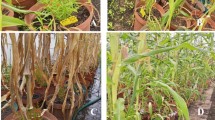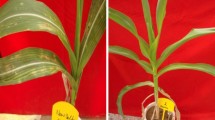Abstract
S2 line and S2 test-cross recurrent selection procedures were initiated to improve the resistance of a maize (Zea mays L.) population to the spotted stemborer, Chilo partellus (Swinhoe) (Lepidoptera: Pyralidae). Thirty-five selections developed from the population were evaluated for resistance to the stemborer in western Kenya. Resistance was rated according to leaf feeding (LF), stem tunnelling (ST) and deadheart formation (DH) following artificial infestation with first-instar C. partellus. Larval establishment and growth were also assessed. The reduction in foliar damage ratings, percentage stem length tunnelled, and percentage of plants showing deadheart after one cycle of recurrent selection were 4.38 %, 74.80 % and 13.92 %, respectively. A very low larval establishment on all the selections was attributed to their resistance to C. partellus attack. Results from this study indicated low levels of larval growth and development. It is concluded that antibiosis was the type of resistance mechanism against C. partellus in the maize populations investigated and that more cycles of selection are required to significantly shift the gene frequencies for resistance.
Résumé
La sélection récurrente des lignées pures S2 et les hybrides de S2 issues des croisements réciproques a été initiée pour améliorer la résistance d’une population de maïs (Zea mays L.) contre l’attaque par la foreuse tachetée, Chilo partellus (Swinhoe) (Lepidoptera: Pyralidae). Trente cinq sélections issues de cette population ont été évaluées pour leur résistance contre la foreuse tachetée, à l’ouest du Kenya. Après une inoculation artificielle du maïs au moyen des larves du premier stade de C. partellus, le degré de résistance était estimé par échelle de cotation pour les lésions foliaires et par pourcentage du nombre et de la longueur des galeries pratiquées dans les tiges ainsi que celui des plants avec la pourriture du coeur. Le taux de survie des larves ainsi leur croissance ont également fait objet de suivi. Après un cycle de sélection récurrente, les taux respectifs de réduction étaient de 4,38% pour des lésions foliaires, de 74,80% pour la longueur des galeries dans la tige et de 13,92% pour le nombre de plants avec pourriture du coeur. Un niveau très bas de survie des larves sur toutes les sélections fut attribué à la résistance de plantes contre C. partellus. Les résultats obtenus de cette étude ont montré des niveaux très bas de croissance et de développement larvaire. On a conclu que le type de mécanisme régissant la résistance contre C. partellus au sein des populations étudiées de maïs était imputable à l’effet d’une antibiose et que des cycles complémentaires de sélection sont nécessaires pour une profonde mutation et une meilleure stabilisation du gène de résistance.
Similar content being viewed by others
References
Ampofo J. K. O., Saxena K. N., Kibuka J. G. and Nyangiri E. O. (1986) Evaluation of some maize cultivars for resistance to the spotted stem borer, Chilo partellus (Swinhoe) in western Kenya. Maydica 31, 379–389.
Davis F. M. and Williams W. P. (1986) Survival, growth and development of South Western corn borer (Lepidoptera: Pyralidae) on resistant and susceptible maize hybrids. J. Econ. Entomol. 79, 847–851.
Davis F. M., Ng S. S. and Williams W. P. (1989) Mechanisms of resistance in corn to leaf feeding by South Western corn borer and European corn borer (Lepidoptera: Pyralidae). J. Econ. Entomol. 82, 919–922.
Hazel L. N. (1943) The genetic basis of constructing selection indices. Genetics 28, 476–490.
ICIPE (1990) Improvement and development of maize for resistance to stemborers. 18th Annual Report, 26–28.
Kumar H. (1988a) Effects of stalk damage on growth and yield of certain maize cultivars by the maize stalk borer, Chilo partellus. Entomol. Exp. Appl. 46, 149–153.
Kumar H. (1988b) Oviposition and larval behaviour of stalk borer (Otilo partellus) on susceptible and resistant varieties of maize (Zea mays L). Indian J. Agrie. Sci. 58, 918–921.
Kumar H. (1991) Host plant resistance in maize to first generation Chilo partellus. Annual Plant Resistance to Insects Neiusletter 17.
Kumar H., Enock E. O., Nyangiri M. O. and Asino G. O. (1993) Colonization responses and damage by Chilo partellus (Lepidoptera: Pyralidae) to four variably resistant cultivars of maize. J. Econ. Entomol. 86, 739–746.
Mulamba N. N and Mock J. J. (1978) Improvement of yield potential of Eto Blanco maize (Zea mays L.) population by breeding for plant traits. Egyptian f. Genet. Cytol. 7, 40–51.
Ochieng R. S., Onyango F. O. and Bungu M. D. O. (1985) Improvement of techniques for mass culture of Chilo partellus (Swinhoe). Insect Sci. Applic. 6, 425–428.
Owens J. C. (1975) An explanation of terms used in insect resistance to plants. Ioioa St. J. Res. 49, 513–517.
Painter R. M. (1951) Insect Resistance in Crop Plants. McMillan, New York. 520 pp.
Smith H. F. (1936) A discriminant function for plant selection. Ann. Eugen. 7, 240–256.
Steel R. G. D. and Torrie J. H. (1980) Principles and Procedures of Statistics. 2nd ed. McGraw-Hill Book Company, London, 633 pp.
Wilson R. L., Wiseman B. R. and Widstrom N. W. (1984) Growth response of corn earworm larvae on meridic diets containing fresh and lympholized corn silk.. Econ. Entomol. 77, 1159–1162.
Wiseman B. R. (1985) Types and mechanisms of host plant resistance to insect attack. Insect Sci. Applic. 6, 239–242.
Wiseman B. R. and Davis F. M. (1990) Plant resistance to insects attacking corn and grain sorghum. Fla. Entomol. 73, 466–468.
Author information
Authors and Affiliations
Rights and permissions
About this article
Cite this article
Mutinda, C.J.M., Saxena, K.N., Ajala, S.O. et al. Evidence of Antibiosis Resistance to the Spotted Stemborer, Chilo partellus (Swinhoe) in a Maize (Zea mays L.) Population. Int J Trop Insect Sci 18, 217–224 (1998). https://doi.org/10.1017/S1742758400023432
Accepted:
Published:
Issue Date:
DOI: https://doi.org/10.1017/S1742758400023432




